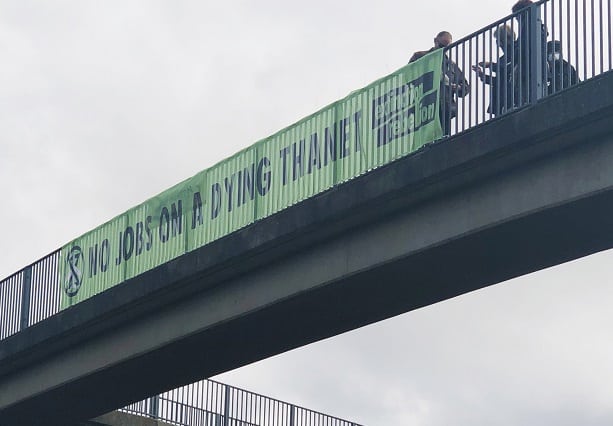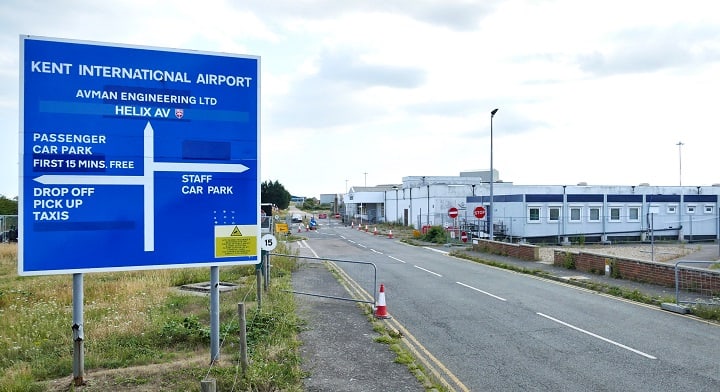
Environmental group Extinction Rebellion (XR) Thanet has launched a ‘guerrilla campaign’ today (August 29) to demonstrate its opposition to freight hub plans for Manston Airport.
Banners and posters are being put up in areas which are deemed likely to come under the flight paths, including the A299 at St Nicholas-at-Wade.
RiverOak Strategic Partners (RSP) was granted development consent by the government in July. The firm says the aim is to reopen the airport in a £300m project to create an air freight hub with passenger services and business aviation. Plans for construction include 19 freight stands and four passenger stands for aircraft as well as warehousing and fuel storage to meet forecast demand.
Peter Batt, of XR Thanet, said: “Given the government and so many Kent councils have recognised the need to act by declaring a climate emergency, it is truly staggering that so many of our elected representatives have so abjectly failed to tell the truth and safeguard their communities’ long-term interests.
“Aviation is a significant and growing contributor to global greenhouse gas (GHG) emissions. We know from the science that these emissions are altering the chemical balance of the Earth’s atmosphere and leading us towards catastrophic global warming.
“There is no point going for economic growth if it means we won’t be alive to enjoy the benefits.

“There are no jobs on a dead planet and it is long since time that our elected representatives took the threat to our climate seriously and rejected schemes like this, which has been judged by planning and aviation experts and unviable and unnecessary.”
Mr Batt says there has not been adequate consultation on the impacts and believes people further afield, in Deal and Whitstable, may not be aware they could come under the flight paths. He also says there is no evidence a cargo freight hub at Manston will be successful.
He said: “In the very unlikely event that the hub becomes successful, its success will create other economic, environmental and health costs which will more than offset its benefits – as the Planning Inspectorate made clear in its final report on the development consent order.”
He added: “The government should be looking to decarbonise our economy so as to ensure a sustainable future. They are failing to do this, and so our campaign at XR Thanet is a vote for people and planet over an unnecessary, noisy and polluting airport.”
DCO stipulations and flight path process
The DCO stipulates the operation of the airport will be subject to a total annual cargo air transport movement limit of 17,170; a total annual passenger air transport movement limit of 9,298; and a total annual general aviation movement limit of 38,000.
At peak there will be five large aircraft movements per hour. The DCO prohibits night flights but a delayed arrival could happen within those restricted hours of 11pm to 6am.
Focus group discussions on options for flight paths began last year. A second stage involved consultation with airspace users, air navigation service providers, local authorities and parish councils.
The results of this are now being prepared into a report. RSP say public consultation will be held at Stage 3 of the air space process and maps represent a number of options put forward to the focus groups which will eventually be refined. Public consultation is likely to take place at the end of the year/beginning of 2021.

An RSP spokesperson said: ““The Civil Aviation Authority CAP 1616 process for airspace change is carried out in 7 stages, with 14 very precise steps – each of which takes many months to complete and only when each step is approved by the CAA can you proceed to the next one.
“When the Design Options are produced, based upon the Airspace Design Principles, a comprehensive public consultation will take place during Stage 3 as a key part of the airspace change process where we will take into account the wider views of residents, businesses, communities, the public and other stakeholders.”
The Civil Aviation Authority flight path process will look at areas including how many flights go over Ramsgate and how many go in the direction over St Nicholas-at-Wade. The final flight path decision will be made by the CAA.

RSP director Tony Freudmann says airport plans include ‘carbon neutral’ measures to meet the Paris Accord and RSP is ‘comfortable’ with the ability to reach those.
He said measures would include: “using electric and hydrogen powered vehicles, keeping the number of road users to a minimum (with the use of local employees) and hopefully being able to take cargo to Port Ramsgate.”
Read here: Barristers issue claim for legal challenge over Manston airport development
Read here: RSP plans for education and training ‘academy’ at Manston airport site

